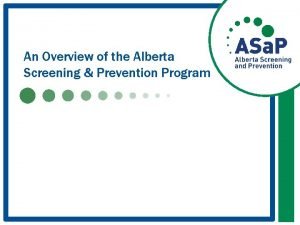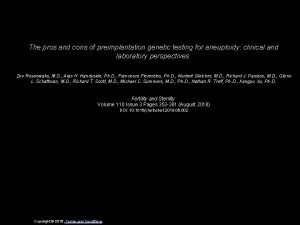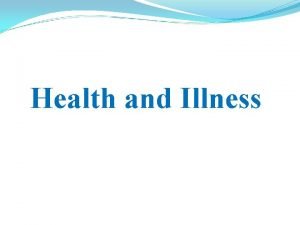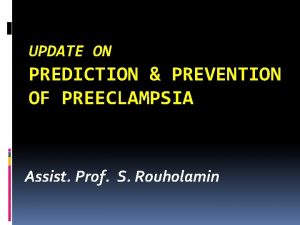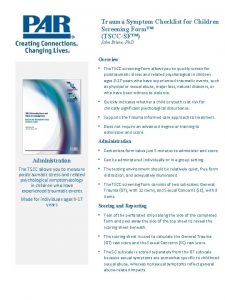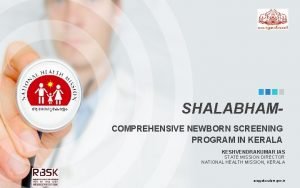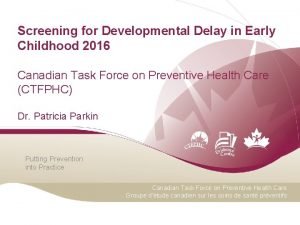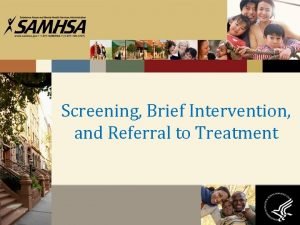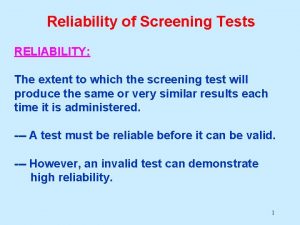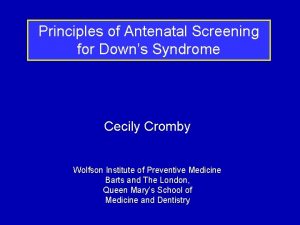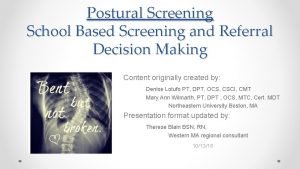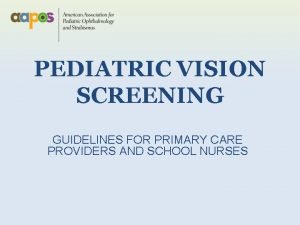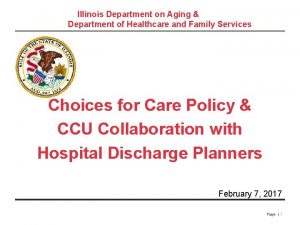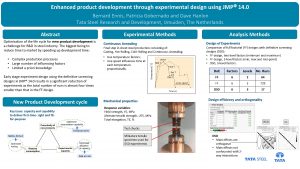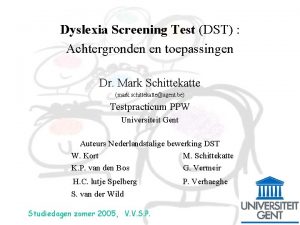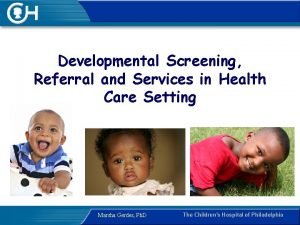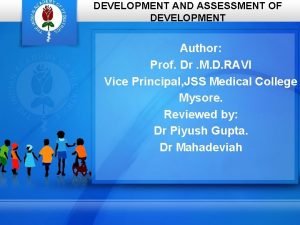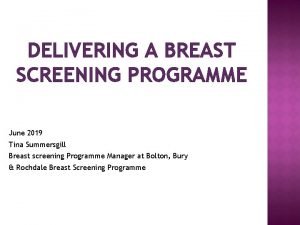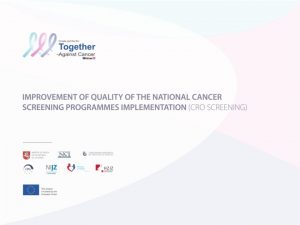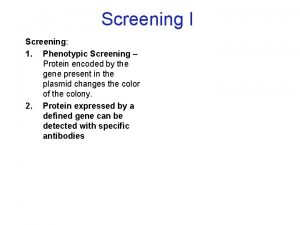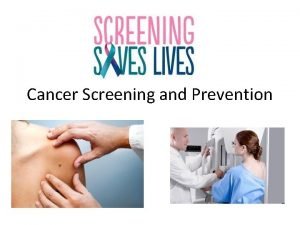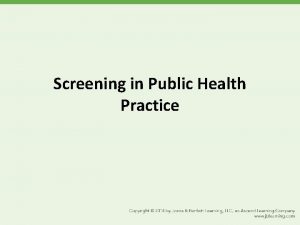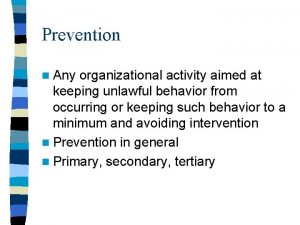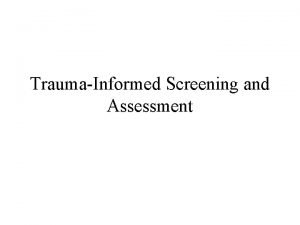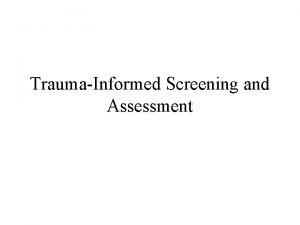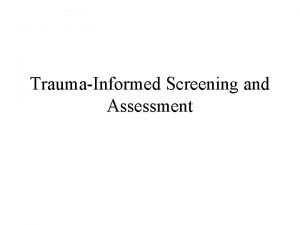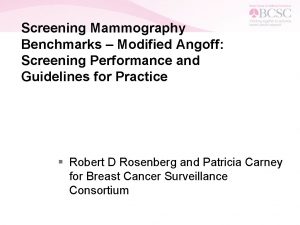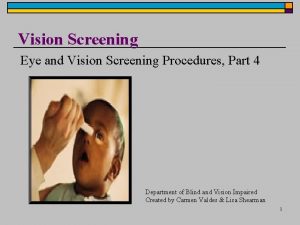Prevention And Screening Prevention Definition Actions aimed at














































- Slides: 46

Prevention And Screening

Prevention Definition Actions aimed at eradicating, eliminating or minimizing the impact of disease and disability, or if none of these are feasible, retarding the progress of the disease and disability. 2

Prevention is best defined in the context of levels Primary (prevent the disease) Secondary( early detection and treatment • Tertiary prevention (treat and minimize disability) • A fourth level, called primordial prevention(prevent the risk factors). • • 3

Determinants of Prevention • Successful prevention depends upon: – a knowledge of causation, – dynamics of transmission, – identification of risk factors and risk groups, – availability of prophylactic or early detection and treatment measures, 4

–an organization for applying these measures to appropriate persons or groups, and –continuous evaluation of and development of procedures applied 5

Primordial prevention • Primordial prevention consists of actions and measures - in the form of environmental, economic, social, and behavioral conditions and cultural patterns of living etc. - that inhibit the emergence of risk factors in countries or population groups in which they have not yet appeared 6

• Primordial prevention, a relatively new concept, is receiving special attention in the prevention of chronic diseases. For example, many adult health problems (e. g. obesity, hypertension) have their early origins in childhood, because this is the time when lifestyles are formed.

• General access to energy-dense diets coupled with typically sedentary urban lifestyles creates a trend toward obesity and chronic disease.

• It is important to change the milieu that promotes major risk factor development. Primordial prevention calls for changing the socio-economic status of society. A better socio-economic status correlates inversely with lifestyle factors like smoking, abnormal food patterns and exercise.

• Primordial prevention begins in childhood when health risk behaviour begins. Parents, teachers and peer groups are important in imparting ﻧﻘﻞ health education to children.


Examples of primordial prevention actions (II): Comprehensive policies to discourage smoking ﺳﻴﺎﺳﺎﺕ ﺷﺎﻣﻠﺔ ﻟﻠﺤﺪ ﻣﻦ ﺍﻟﺘﺪﺧﻴﻦ

Examples of primordial prevention actions (III): Programs to promote regular physical activity ﺑﺮﺍﻣﺞ ﻟﺘﻌﺰﻳﺰ ﻣﻤﺎﺭﺳﺔ ﺍﻟﻨﺸﺎﻁ ﺍﻟﺒﺪﻧﻲ ﺑﺎﻧﺘﻈﺎﻡ

Primary prevention • Efforts are directed at healthy individuals to avoid the development of disease. • Primary prevention may be accomplished by measures of “Health promotion” and “specific protection”

Primary prevention Achieved by Health promotion ﺗﻌﺰﻳﺰ ﺍﻟﺼﺤﺔ Health education Environmental modifications Nutritional interventions Life style and behavioral changes Specific protection Immunization and seroprophylaxis chemoprophylaxis Use of specific nutrients or supplementations Protection against occupational hazards Safety of drugs and foods Control of environmental hazards, e. g. air pollution

Health promotion • Health promotion is “ the process of enabling people to increase control over the determinants of health and thereby improve their health”.

Approaches for Primary Prevention • The WHO has recommended the following approaches for the primary prevention of chronic diseases where the risk factors are established: – a. Population (mass) strategy – b. High -risk strategy

Population (mass) strategy • “Population strategy" is directed at the whole population irrespective of individual risk levels. • For example, studies have shown that even a small reduction in the average blood pressure or serum cholesterol of a population would produce a large reduction in the incidence of cardiovascular disease • The population approach is directed towards socio-economic, behavioral and lifestyle changes

High -risk strategy • The high -risk strategy aims to bring preventive care to individuals at special risk. • This requires detection of individuals at high risk by the optimum use of clinical methods.

Secondary prevention • Efforts are those aimed at detecting early disease so that further morbidity or symptoms can be reduced. • The specific interventions are: early diagnosis (e. g. screening tests, and case finding programs…. ) and adequate treatment. • an example is screening FBS in hypertensive pt before they developed any symptoms of DM

Tertiary prevention • Efforts intended to improve both the health outcomes of people with a diagnosed disease and preventing further morbidity from the condition • Intervention that should be accomplished in the stage of tertiary prevention are disability limitation, and rehabilitation

Disability limitation disease impairment disability handicap

Impairment • Impairment is “any loss or abnormality of psychological, physiological or anatomical structure or function. ”

Disability • Disability is “any restriction or lack of ability to perform an activity in the manner or within the range considered normal for the human being. ”

Handicap • Handicap is termed as “a disadvantage for a given individual, resulting from an impairment or disability, that limits or prevents the fulfillment ﺗﻨﻔﻴﺬ of a role in the community that is normal (depending on age, sex, and social and cultural factors) for that individual. ”

Rehabilitation • Rehabilitation is “ the combined and coordinated use of medical, social, educational, and vocational measures for training and retraining the individual to the highest possible level of functional ability. ”

Rehabilitation Medical rehabilitation Vocational rehabilitation Social rehabilitation Psychological rehabilitation

• Tertiary prevention is conducted primarily by individuals and their health care practitioners (physicians, nurses and ﻣﺘﺤﺎﻟﻒ allied health professionals). In conducting tertiary prevention, health care professionals may make use of rehabilitation programs, chronic pain management programs and patient support groups

• . For people with severe arthritis, tertiary prevention often includes doing exercises, physical therapy and taking medication to control inflammation and pain. For people with cancer, tertiary prevention often includes measures to keep the patient comfortable and the disease in remission for as long as possible. For people with disabling injuries, tertiary prevention includes intensive, long-term physical therapy to regain use of limbs or develop alternate means for independent functioning

Screening for Disease

screening Screening is testing for a health problem or risk factor when there are no recognized signs or symptoms that would indicate the presence of risk factor


Screening test • Reliable – get same result each time • Validity – get the correct result – Sensitive – correctly classify cases – Specificity – correctly classify noncases

Reliability • Reliability = Repeatability Get same result : • Each time • From each instrument • From each rater

Validity 1. Sensitivity =Probability (proportion) of correct classification of cases TRUE Cases / all cases 2. Specificity= Probability (proportion) of correct classification of noncases TRUE Noncases identified / all noncases

The Principles of Screening • The choice of disease for which to screen; • The nature of the screening test or tests to be used; • The availability of a treatment for those found to have the disease; • The relative costs of the screening.

• The disease must be an important health problem. • There should be a recognizable latent or early symptomatic stage. • The natural history of the disease, including latent to declared disease, should be adequately understood.

When to screen?

• There should be a suitable test or examination. • The test should be acceptable to the population.

Outcomes of a Screening Test True Disease Status Screening Test Positive Negative Total Positive True Positives (TP) False Positives (FP) TP+FP Negative False Negatives (FN) True Negatives (TN) FN+TN FP+TN TP+FP+FN+TN Total TP+FN

• There should be an acceptable treatment for the patients with recognized disease. • There should be facilities for diagnosis and treatment should be available. • There should be an agreed policy on whom to treat as patients.

• The cost of case finding (including diagnosis and treatment of patients diagnosed) should be economically balanced in relation to possible expenditure on medical care as a whole. • Case finding should be a continuing process and not a "once for all" project.

Limitations of screening The tests used in screening are not perfect. The test result may incorrectly show positive for those without disease (false positive), or negative for people who have the condition (false negative). Limitations of screening programs can include:

• Screening can involve cost and use of medical resources on a majority of people who do not need treatment. • Adverse effects of screening procedure (e. g. stress and anxiety, discomfort, radiation exposure, chemical exposure). • Stress and anxiety caused by a false positive screening result. • Unnecessary investigation and treatment of false positive results. • Stress and anxiety caused by prolonging knowledge of an illness without any improvement in outcome. • A false sense of security caused by false negatives, which may delay final diagnosis.

Common screening programs • Cancer screening – Pap smear or liquid-based cytology to detect potentially precancerous lesions and prevent cervical cancer – Mammography to detect breast cancer – Colonoscopy to detect colorectal cancer – Faecal occult blood test screening for bowel cancer • PPD test to screen for exposure to tuberculosis • Beck Depression Inventory to screen for depression • Alpha-fetoprotein, blood tests and ultrasound scans for pregnant women to detect fetal abnormalities • Ophthalmoscopy or digital photography and image grading for diabetic retinopathy

Summary • Prevention defined as Actions aimed at eradicating, eliminating or minimizing the impact of disease and disability • Screening is the testing of apparently healthy populations to identify previously undiagnosed diseases or people at high risk of developing a disease. • Principles of Screening: disease, test, treatment and cost. What is the next step? Define the validity of the screening test and put screening to use in the population.
 Primary prevention secondary prevention tertiary prevention
Primary prevention secondary prevention tertiary prevention Alberta screening and prevention program
Alberta screening and prevention program Robert vischer empathy theory
Robert vischer empathy theory Systematic inquiry aimed at the discovery of new knowledge
Systematic inquiry aimed at the discovery of new knowledge Secondary group examples
Secondary group examples Sense 8
Sense 8 Systematic inquiry aimed at the discovery of new knowledge
Systematic inquiry aimed at the discovery of new knowledge Selection criteria for international assignments
Selection criteria for international assignments Idea screening in entrepreneurship
Idea screening in entrepreneurship Use case for atm withdrawal
Use case for atm withdrawal Waterfall and shower approach
Waterfall and shower approach Adjudication status pending hireright
Adjudication status pending hireright Yeast artificial chromosome
Yeast artificial chromosome Payback period example
Payback period example Blue-white selection
Blue-white selection Class diagram for airport check-in and security screening
Class diagram for airport check-in and security screening Preimplantation genetic screening pros and cons
Preimplantation genetic screening pros and cons Screening decisions and preference decisions
Screening decisions and preference decisions Situational crime prevention definition
Situational crime prevention definition Ron clarke 1992
Ron clarke 1992 Illness prevention definition
Illness prevention definition Phonics screening test 2019
Phonics screening test 2019 Mgso4 mechanism of action in eclampsia
Mgso4 mechanism of action in eclampsia What is a screening interview
What is a screening interview Tscc screening form
Tscc screening form Jatak seva
Jatak seva Denver developmental screening test
Denver developmental screening test Crafft screening tool
Crafft screening tool Dettato con doppie e accenti
Dettato con doppie e accenti Rias assessment
Rias assessment Reliability of screening test
Reliability of screening test Down syndrome screening results
Down syndrome screening results What is a psp report
What is a psp report Risser sign
Risser sign Phytochemical screening methods
Phytochemical screening methods Peehip wellness screening form 2021
Peehip wellness screening form 2021 Pediatric vision screening guidelines
Pediatric vision screening guidelines Fine grained screening
Fine grained screening Obra screening illinois
Obra screening illinois Screening router
Screening router Enhanced product development
Enhanced product development Dst test
Dst test Developmental screening vs surveillance
Developmental screening vs surveillance Trivandrum developmental screening chart
Trivandrum developmental screening chart [email protected]
[email protected] Cro screening
Cro screening Swyc forms
Swyc forms

